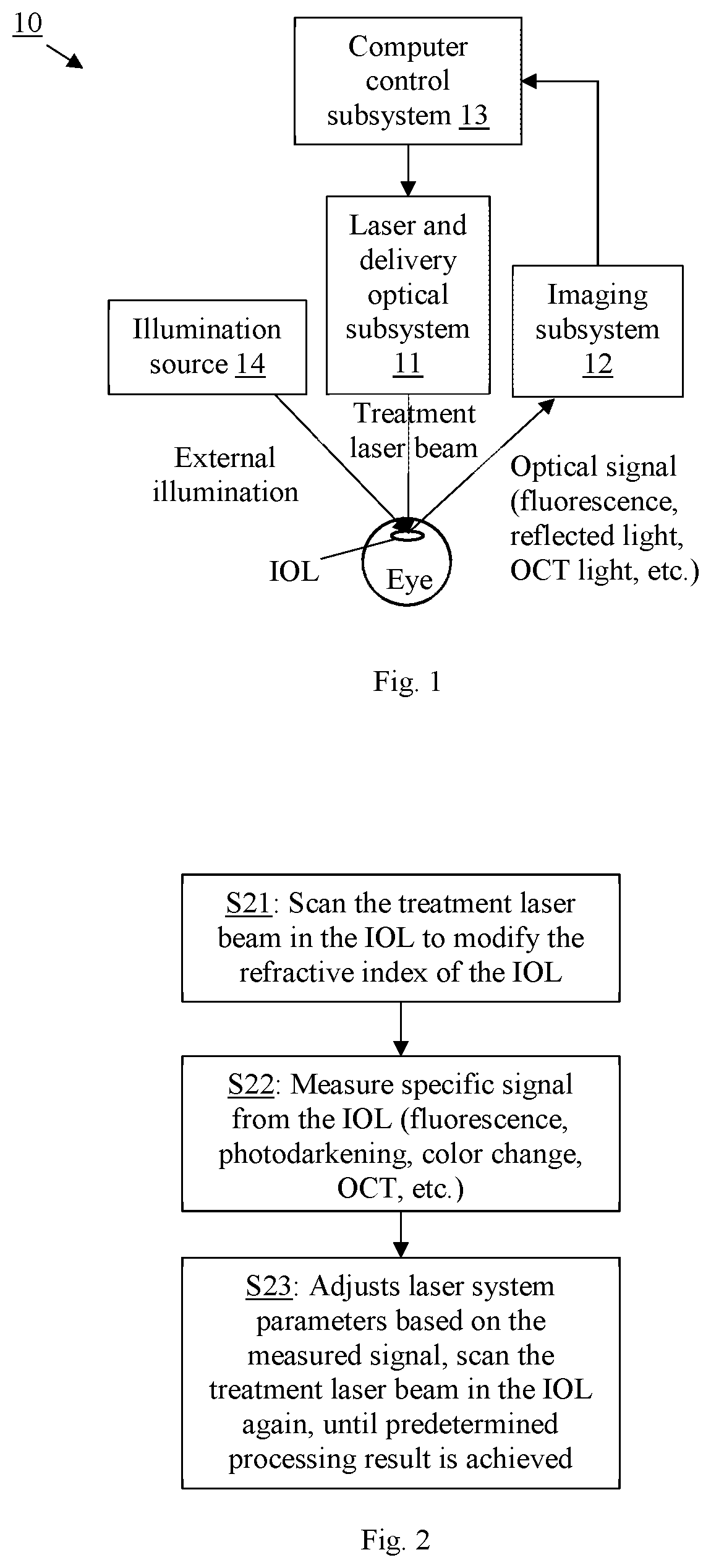Process monitoring and control during laser-based refractive index modification of intraocular lenses in patients
a technology of laser-based refractive index and which is applied in the field of process monitoring and control during laser-based refractive index modification of intraocular lenses in patients, can solve the problems of less effective treatment, missed matching of existing matching, and left-over visual significant refractive error of cataract patients
- Summary
- Abstract
- Description
- Claims
- Application Information
AI Technical Summary
Benefits of technology
Problems solved by technology
Method used
Image
Examples
first embodiment
[0020]In the present invention, during in situ laser treatment of the IOL to modify the refractive index of the IOL material, while the treatment laser beam is scanned in the IOL, the treatment laser induced fluorescence (which may be referred to as autofluorescence) of the IOL material is measured and used as an indicator of the effectiveness of the laser induced processing of the IOL. The fluorescence signal can then be used to automatically adjust the treatment laser and optical subsystem 11 and perform further treatment so as to achieve the intended treatment outcome. Monitoring may be achieved by the imaging subsystem 12 which may use a video camera of the ophthalmic laser surgical system or a separate detector which is optimized for the detection of the induced fluorescence.
[0021]FIG. 3 shows an example of the aforementioned process monitoring conditions which allow optimization of the laser treatment process. This example shows the fluorescence signal 32 in the IOL material 3...
second embodiment
[0026]In the present invention, during in situ laser treatment of the IOL, an external fluorescence illumination source 14 (different from the treatment laser 11) is used to illuminate the IOL to induce fluorescence, which allows visualization of the fluorescence signal as indicator of the effectiveness of the laser induced processing of the IOL. The illumination (excitation) light wavelength may be optimized to maximize the efficacy of light conversion. The external illumination source 14 may be LEDs with an appropriate wavelength, or a secondary external laser light source with an appropriate wavelength. A wide range of excitation wavelengths are usable. Preferably, the excitation wavelengths are in the UV-blue spectrum range, and more preferably, between 360-410 nm. The imaging subsystem 12 may be a video camera of the ophthalmic laser surgical system or a separate detector optimized for the detection of the induced fluorescence.
[0027]FIG. 4 shows an example of a processed IOL 41...
third embodiment
[0032]In the present invention, during in situ laser treatment of the IOL, a temporary photodarkening effect, which is an effect of the chemical processing of the IOL, may be utilized as a process monitoring parameter. Preferably, retro-illumination (illumination from behind the IOL by light reflected from other structures of the eye) is used to produce images with better contrast. The more the refractive index change achieved in the IOL, the more the material will be darkened. The video camera (the imaging subsystem 12) of the ophthalmic laser system may be used to visualize and measure photodarkening effect as an indicator of the effectiveness of the laser induced processing of the IOL. Based on the observed photodarkening effect, the laser system may be adjusted and further treatment performed so as to correct possible transmission induced variances.
[0033]FIG. 6 shows the photodarkening during processing of the IOL with the femtosecond laser. With retro illumination, the Fresnel ...
PUM
| Property | Measurement | Unit |
|---|---|---|
| excitation wavelengths | aaaaa | aaaaa |
| refractive index | aaaaa | aaaaa |
| fluorescent | aaaaa | aaaaa |
Abstract
Description
Claims
Application Information
 Login to View More
Login to View More - R&D
- Intellectual Property
- Life Sciences
- Materials
- Tech Scout
- Unparalleled Data Quality
- Higher Quality Content
- 60% Fewer Hallucinations
Browse by: Latest US Patents, China's latest patents, Technical Efficacy Thesaurus, Application Domain, Technology Topic, Popular Technical Reports.
© 2025 PatSnap. All rights reserved.Legal|Privacy policy|Modern Slavery Act Transparency Statement|Sitemap|About US| Contact US: help@patsnap.com



